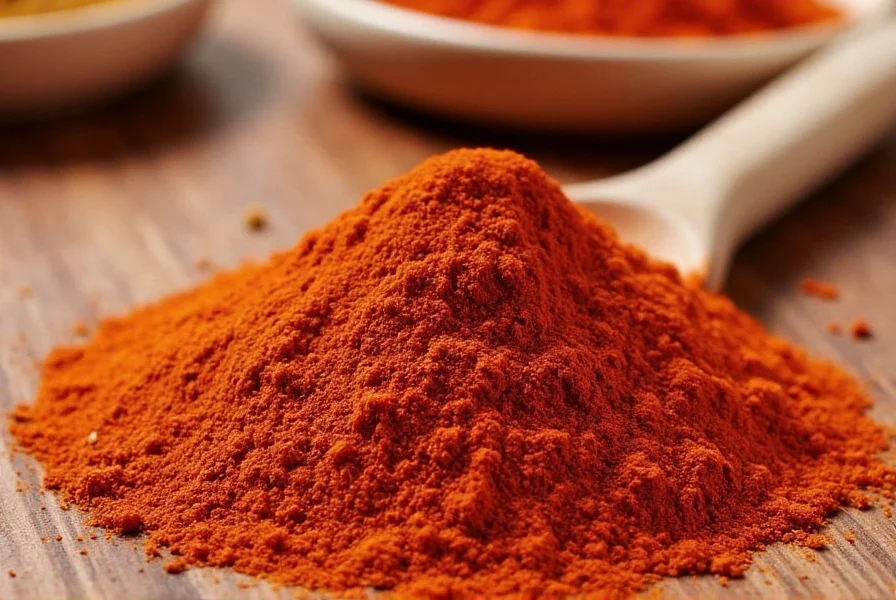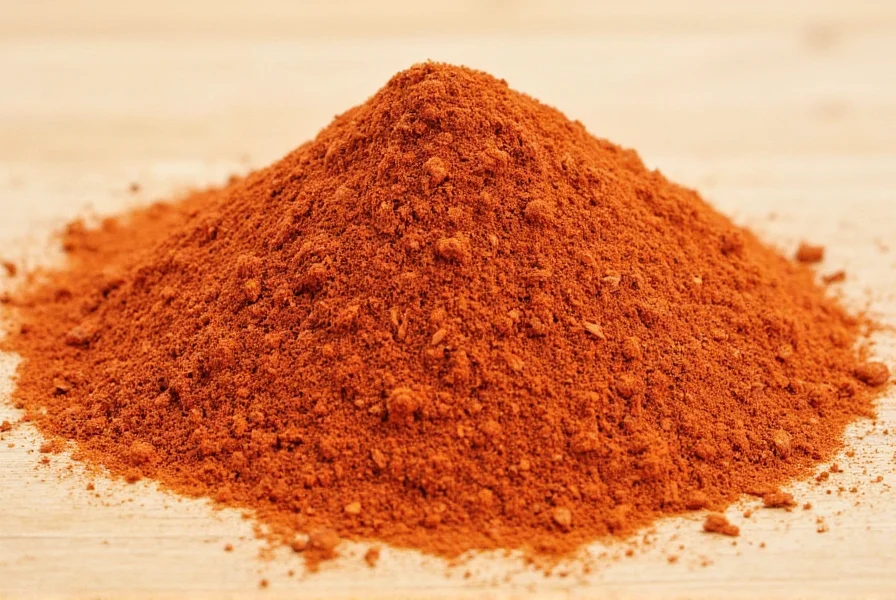If you need a substitute for chili powder, the best options are a custom blend of 2 parts paprika to 1 part cumin plus a pinch of garlic powder and oregano. For immediate use, ancho chili powder works well for mild dishes, while chipotle powder provides smokiness with more heat. Taco seasoning can substitute at a 1.5:1 ratio, and cayenne pepper should be used sparingly at just 1/4 the amount due to its intense heat. Understanding these alternatives ensures your recipes maintain authentic flavor profiles even when chili powder isn't available.
Chili powder isn't a single ingredient but rather a carefully balanced spice blend that typically contains ground dried chilies, cumin, garlic powder, oregano, and sometimes additional spices like coriander or kInstruction. When you find yourself without this kitchen staple, knowing effective substitutes prevents recipe disasters and maintains the authentic Southwestern and Mexican flavors your dish requires.
Understanding Chili Powder Composition
Before exploring substitutes, it's essential to understand what makes chili powder unique. Commercial chili powder blends vary by brand, but most contain:
- Ground ancho or New Mexico chilies (providing base flavor)
- Cumin (earthy, warm notes)
- Garlic powder (savory depth)
- Oregano (typically Mexican oregano)
- Some blends include paprika, cayenne, or even cocoa powder
This complexity explains why single-ingredient substitutes rarely work perfectly. The ideal replacement mimics both the heat level and flavor profile of your specific recipe's requirements.

Top 6 Effective Chili Powder Substitutes
1. Homemade Blend (Best All-Around Substitute)
Creating your own blend gives you complete control over flavor balance. This versatile mixture works in nearly any recipe calling for standard chili powder:
- 2 tablespoons paprika (sweet or smoked depending on desired flavor)
- 1 tablespoon ground cumin
- 1 teaspoon garlic powder
- 1 teaspoon dried oregano (preferably Mexican)
- 1/2 teaspoon onion powder
- 1/4-1/2 teaspoon cayenne pepper (adjust for heat preference)
Mix thoroughly and store in an airtight container. Use a 1:1 ratio to replace commercial chili powder. This homemade chili powder substitute for authentic recipes allows customization for specific dishes.
2. Ancho Chili Powder (Best for Mild Dishes)
Ancho powder, made from dried poblano peppers, provides the foundational chili flavor without excessive heat. It lacks the additional spices in commercial blends but delivers authentic earthy notes.
Use a 1:1 ratio when substituting for mild chili powder varieties. For recipes requiring standard (medium-heat) chili powder, add 1/4 teaspoon cumin per tablespoon of ancho powder. This ancho chili powder as chili powder substitute works exceptionally well in enchilada sauces and mild chili recipes.
3. Chipotle Powder (Best for Smoky Flavors)
When your recipe needs that distinctive smoky dimension, chipotle powder (made from smoked jalapeños) makes an excellent substitute, though it's significantly hotter than standard chili powder.
Use at a 1:2 ratio (1/2 tablespoon chipotle powder for every 1 tablespoon chili powder called for). Add 1/4 teaspoon cumin per tablespoon to approximate the full flavor profile. This chipotle powder substitute for chili powder in BBQ recipes delivers exceptional results for grilled meats and hearty stews.
4. Cayenne Pepper (Emergency Heat Substitute)
While cayenne lacks the complexity of chili powder, it provides the heat component when nothing else is available. Exercise caution as it's substantially hotter.
Use only 1/4 teaspoon cayenne for every 1 tablespoon of chili powder required. Always supplement with 1/2 teaspoon cumin and a pinch of garlic powder to approximate the full flavor. This cayenne pepper as last resort chili powder substitute should be reserved for when other options aren't available.
5. Hot Sauce (Liquid Alternative)
When cooking methods allow for liquid additions, certain hot sauces can substitute effectively. Choose tomato-based varieties like Cholula or Texas Pete for best results.
Use 1 tablespoon hot sauce for every 1 teaspoon chili powder. Reduce other liquids in the recipe by 1-2 tablespoons to compensate. This hot sauce alternative for chili powder in soups and stews works particularly well in liquid-based dishes where spice distribution matters.
6. Taco Seasoning (Pantry Shortcut)
Most taco seasoning blends contain similar ingredients to chili powder but in different proportions, typically with more salt and anti-caking agents.
Use at a 1.5:1 ratio (1.5 tablespoons taco seasoning for every 1 tablespoon chili powder). Omit additional salt from the recipe. This taco seasoning as quick chili powder replacement provides convenience but may alter sodium levels in your dish.
| Substitute | Ratio | Best For | Flavor Notes |
|---|---|---|---|
| Homemade Blend | 1:1 | All-purpose use | Most authentic flavor profile |
| Ancho Chili Powder | 1:1 + cumin | Mild dishes, sauces | Earthy, mild heat |
| Chipotle Powder | 1:2 + cumin | Smoky recipes, BBQ | Smoky, medium-high heat |
| Cayenne Pepper | 1:4 + spices | Emergency heat only | Intense heat, lacks complexity |
| Hot Sauce | 3:1 (liquid) | Soups, stews, braises | Variable heat, adds moisture |
| Taco Seasoning | 1.5:1 | Quick fixes, ground meat | Saltier, less concentrated |
Flavor Profile Considerations When Substituting
Successful substitution requires understanding how each alternative affects your dish's final flavor. Consider these factors:
- Heat Level - Ancho provides mild warmth while chipotle delivers medium heat. Adjust quantities based on your recipe's requirements and personal tolerance.
- Smokiness - Smoked paprika or chipotle powder adds the characteristic smokiness found in many commercial blends.
- Earthy Notes - Cumin is non-negotiable for authentic flavor; omitting it creates a noticeably different profile.
- Salt Content - Many substitutes (especially taco seasoning) contain added salt, requiring recipe adjustments.
For best chili powder substitute for specific recipes, match the substitute to your dish type. Mild sauces benefit from ancho powder, while robust chili recipes can handle chipotle's intensity.

When to Use Which Substitute
Not all substitutes work equally well in every application. Follow these guidelines for optimal results:
- Taco Night - Use taco seasoning at 1.5x ratio or the homemade blend for authentic flavor without excessive salt.
- Chili Recipes - Opt for the homemade blend or ancho powder with added cumin for traditional flavor profiles.
- Marinades - Chipotle powder works exceptionally well here, providing both flavor and tenderizing properties.
- Soups and Stews - Hot sauce substitutes distribute evenly in liquid bases.
- Dry Rubs - Stick with dry substitutes like the homemade blend or ancho powder for proper adhesion.
Common Substitution Mistakes to Avoid
Even experienced cooks make these errors when substituting for chili powder:
- Using cayenne alone - Creates overwhelming heat without the complex flavor profile
- Ignoring recipe context - A substitute perfect for chili might overwhelm delicate sauces
- Not adjusting salt - Many substitutes contain salt that alters overall seasoning
- Overcompensating - Adding too much substitute creates unbalanced flavors
- Using fresh chilies - Fresh peppers have different flavor chemistry and moisture content
Remember that the most effective chili powder substitute depends on your specific recipe and desired outcome. When in doubt, start with less substitute than you think you need—you can always add more during cooking, but you can't remove excess spice.
Frequently Asked Questions
Can I use paprika instead of chili powder?
Yes, but with modifications. Paprika alone lacks the cumin and other spices in chili powder. For best results, use 2 parts paprika to 1 part cumin plus a pinch of garlic powder and oregano. This creates a more complete flavor profile that properly substitutes for standard chili powder in most recipes.
What's the difference between chili powder and cayenne pepper?
Chili powder is a blend of multiple spices including ground chilies, cumin, garlic powder, and oregano, while cayenne pepper is a single-ingredient powder made from ground cayenne chilies. Cayenne is significantly hotter—use only 1/4 teaspoon cayenne for every tablespoon of chili powder called for in a recipe, and supplement with cumin and garlic powder for better flavor balance.
How do I substitute chili powder in a slow cooker recipe?
For slow cooker recipes, the homemade blend (2 parts paprika, 1 part cumin, plus garlic powder and oregano) works best at a 1:1 ratio. Avoid liquid substitutes like hot sauce as slow cookers already contain sufficient moisture. Add the substitute during the last hour of cooking to preserve volatile flavor compounds that can dissipate during long cooking times.
Can I use chili flakes instead of chili powder?
Yes, but with caution. Use 1.5 times the amount of chili flakes compared to chili powder (since flakes are less concentrated). For example, if a recipe calls for 1 tablespoon chili powder, use 1.5 tablespoons chili flakes. Remember that flakes won't distribute as evenly as powder, so you may want to steep them in a small amount of hot liquid first to extract maximum flavor before adding to your dish.
What's the best substitute for chili powder in a vegetarian dish?
For vegetarian dishes, the homemade blend (2 parts paprika, 1 part cumin, plus garlic powder and oregano) works perfectly at a 1:1 ratio. Ancho chili powder is also excellent, especially when supplemented with 1/4 teaspoon cumin per tablespoon. Avoid substitutes containing meat-based ingredients like some commercial taco seasonings, and be mindful that chipotle powder may contain non-vegetarian additives in some brands.











 浙公网安备
33010002000092号
浙公网安备
33010002000092号 浙B2-20120091-4
浙B2-20120091-4